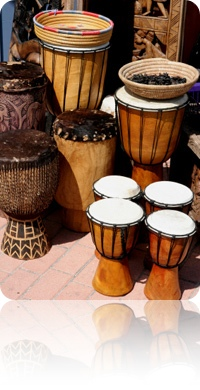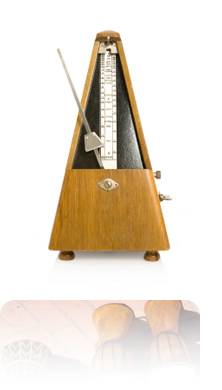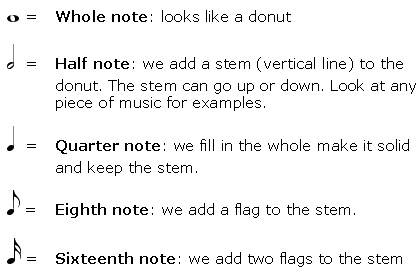Lesson 3: Rhythm
Lesson 3: Rhythm

Lesson 3: Rhythm
Rhythm
A famous George and Ira Gershwin song published in the 1930s proclaimed, “I’ve got rhythm, I’ve got music.” Rhythm represents another fundamental aspect of music and perhaps the most fundamental of all musical elements. It is the timing of the musical sounds or notes in the music. Rhythm is composed of both the strong, accented pulses as well as the weaker, unaccented pulses. The pattern of these pulses comprises rhythm. Some of the earliest music consisted almost entirely of rhythm, in the form of drumming or clapping.

Rhythm, in one form or another, exists all around us. Some scholars have argued that the need or recognition for rhythm begins for humans in their mother’s womb, where their mother’s heartbeat keeps a steady pulse. We can also find rhythm in other sounds around us, including the footsteps of another or the chiming of a clock as the hour changes, as we tend to give these sounds a musical element in our heads. We might also argue that our daily lives have a rhythm or spacing to them. We often have schedules and do particular things at particular times, such as sleeping and eating. This is why we refer to it as the “rhythm of life.” Rhythm also occurs in the spoken language, although you may not have thought about this before. In fact, prosody is the study of rhythm, pitch, and other aspects within language. While each of these examples is different than music, they all represent the idea of space, pattern, and repetition in sound or movement. As rhythm exists around us daily, you are probably already aware of rhythm in music, even if you did not know the term to attach to it. Rhythm is the aspect that makes you want to move to the music, including tapping your foot or dancing.
In music, rhythm is measured. In other words, musicians can measure the timing between the strongest pulsations in the music being played. You may have heard these pulsations referred to as beats. The beat is the basic time unit within a piece of music. You may have seen a music score with bars of notes indicated. These bars of music are giving the musician information not only about the pitch of the music, but also the rhythm. For example, a piece of music may be measured in a 4/4 time. This indicates that each bar of music on the score will have four measured beats in it.
Generally, when using 4/4 time, the first beat will be the strongest beat. In this case, the first beat of the bar is known as the down-beat. It is also the most likely place for a chord change in the music. The third beat in the bar is often the second strongest beat or pulse. In these circumstances, the first and third beats are known as “on” beats, since the emphasis of the music in the bar is on these beats. The emphasis is known as an accent. The second and fourth beats here would be known as “off” beats since emphasis is not on these beats. However, in some cases, unexpected beats will be given emphasis, such as the two and four beats in 4/4 time. Syncopation involves placing emphasis on normally un-emphasized beats or using a rest on a normally emphasized beat. In other words, syncopation involves disrupting or interrupting the expected or normal rhythm of music. Many different types of music, including ska, reggae, rap, jazz, and some forms of metal, use syncopation regularly in the music.

In addition to the emphasis on certain notes within a bar of music, rhythm also indicates the speed of the notes. Tempo is the speed of a given piece of music. If you think about it, tempo plays an important role in determining the mood of a piece of music, along with elements like pitch. Fast tempos create very different moods within music as compared to slow tempos. Today, the tempo is generally indicated by the beats per minute. The faster the tempo, the more beats per minute will be played; the slower the tempo, the fewer beats per minute. A metronome, or a device that produces regular ticks or beats according to the beats per minute, is one way that musicians and composers can help maintain a consistent pace in the music. Musicians have used some common terms for centuries to denote the general tempo for a piece of music:
- Largo: very slow
- Adagio: slow
- Moderato: moderate tempo
- Allegro: fast
- Presto: very fast
As with some of the other notations in music, these terms are general terms, rather than specific. They are dependent on how an individual decides to interpret them. A fast tempo for one individual may be slightly faster or slower than a fast tempo for another, even with the same piece of music.
In designating the beats of music on sheet music or scores, musicians use a series of notations to indicate when a note should be played and the pitch of that note. You have probably seen examples of these notes before, particularly if you play a musical instrument or sing in a choir. Musical notation is similar to a written language. It gives the person reading the notations information about the music. The notes that are used to indicate tempo include:
How are these notes interpreted? Imagine that you are using a 4/4 time, where there are four beats per bar of music. A whole note represents these four beats. In other words, the bar of music would have a single whole note in 4/4 time. If you were using quarter notes, you would use four of those notations to fill up the bar, and each of the other notations is calculated in a similar way (two half notes, eight eighth notes, etc.).
